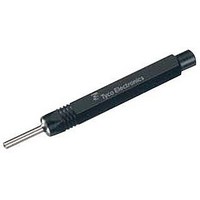1102855-3 TE Connectivity, 1102855-3 Datasheet - Page 33

1102855-3
Manufacturer Part Number
1102855-3
Description
Assembly Tools, HTS Heavy Duty Connectors HTS Tools
Manufacturer
TE Connectivity
Type
Extractor Toolr
Specifications of 1102855-3
Tyco/amp Hvt Series Crimp Contact Heavy-duty Connectors & Solarlok Photovoltaic Interconnection System
RoHS Compliant
Lead Free Status / RoHS Status
Compliant
For Use With
All Wire Sizes
Lead Free Status / Rohs Status
RoHS Compliant part
HTS Industrie Steckverbinder
Verbindlich für Toleranzen der Abmessungen und technische Werte sind ausschließlich die neuesten Tyco Electronics Kundenzeichnungen bzw. Produkt-Spezifikationen, die Sie auf Anfrage erhalten.
All specifications subject to change. Consult Tyco Electronics for latest design specifications.
Die moderne Crimp-Anschlußtechnik weist
gegenüber Schraub- oder Lötanschlüssen
wesentliche technische und wirtschaftliche
Vorteile auf.
Zum Crimpen werden ein- oder mehrdrähtige
Leiter eingesetzt. der Crimpvorgang kann durch
Crimp-Handzangen oder für die Serienfertigung
mit halb- oder vollautomatischen
Crimpmaschinen erfolgen. Mit Vollautomaten
geschieht das Abisolieren der Leiter und das
Crimpen der Kontakte maschinell in einem
Arbeitsgang. Mit Hilfe dieser Crimpwerkzeuge
wird der Anschlußbereich des Crimpkontaktes
verformt und somit eine feste, gasdichte
Verbindung mit dem Leiter hergestellt.
HTS bietet wirtschaftliche und technische Vorteile
mit zwei weltweit verbreiteten Crimpsystemen:
• Präzisions-gedrehte HE, HN.D, HVT, HSM, HSL
• Präzisions-gestanzte HD.M-Crimpkontakte.
1. Die gleichbleibende Crimpqualität garantiert
2. Korrosionsfestigkeit durch annähernde
3. Vorkonfektionierung von Kabelbäumen mit
4. Wesentlich höhere Verdrahtungs-
5. Das Lösen bereits gesteckter Kontakte ist mit
Auswahlhilfe Silber/Goldkontakte:
Die Auswahl o.g. Materialien sollte vor folgendem
Hintergrund stattfinden:
Verschleiß ist auf Grund der Härte der Gold-
oberfläche bei vergoldeten Kontakten geringer,
was auch höhere Steckzyklen erlaubt. Auch ist die
Steckkraft ist bei vergoldeten Kontakten geringer.
Das Widerstandsverhalten bei Gold ist konstanter
aufgrund der geringeren Reaktionsfreudigkeit:
Silber reagiert mit Schwefel und bildet eine dünne
Oxidschicht aus. Diese Schicht wird beim Stecken
problemlos durchbrochen bzw. von größeren
Strömen „verbrannt“.
Unserer Erfahrung nach ist ein Einsatz von
Goldkontakten nur bei Signal-Stömen und -Span-
nungen aufgrund des sehr konstanten (zeitlich)
Widerstandsverhalten notwendig.Bei Anwen-
dungen >5mA und >5V ist der Einsatz von
Silberkontakten aus wirtschaftlichen Gesichts-
punkten sinnvoller.
In nebenstehender Grafik ist diese
Strom/Spannungs Auswahl zusammengefaßt.
Spez. Widerstand: Gold: 0,022 Vmm_/m
Crimpkontakte/Crimp contacts
und HSS-Massiv-Crimpkontakte.
einen konstanten Durchgangswiderstand.
Kaltverschweißung.
Crimpkontakten.
geschwindigkeit.
speziellem Lösewerkzeug möglich.
Silber: 0,015 Vmm_/m
5V
Cross sections of crimp contacts
Gold Kontakt
Gold contact
F-Crimpung für HD.M-Kontakte
Schliffbilder einer Crimpstelle
F crimp for HD.M contacts
Square section crimping
Vierkant Crimpung
Silber Kontakt
Silver contact
5mA
State-of-the-Art crimping technology is superior
to screw or solder terminals compared to tech-
nical and economic perspectives.
Solid or multi strand conductors can be used
for crimping. Crimping is done with manual
crimping tools or semi-automatic crimping
machines. Fully automatic machines perform all
processes from stripping the conductor to crim-
ping the contacts in a single step. The crimping
tools connect the contact and the conductor by
applying pressure to the connection area of the
contact, thus creating a reliable, gas-tight ter-
mination.
HTS offers technical and economic advantages
with two world-wide proven and acknowledged
crimping systems:
• precision-screw machined solid crimp
• precision-stamped HD.M crimp contacts
1. The constant crimp quality ensures a con-
2. Connection is almost cold-welded, giving cor-
3. Preparation of cable harness with crimp
4. Faster termination times.
5. Crimped contacts can be removed with a
How to choose between silver- or gold-plated
contacts:
The choice of either silver- or gold-plated contacts
should be made considering the following:
The surface of gold-plated contacts is harder,
which means less wear and tear and enables hig-
her mating cycles. The mating force of gold-plated
contacts is lower as well.
Gold's resistance performance is more constant
due to its low reactivity. Silver reacts with sulphur
and forms a thin oxidation layer. When mating this
layer can be broken through or 'burnt off' by hig-
her currents.
Our experience has shown that the use of gold-
plated contacts is only necessary with signal cur-
rents and voltages when very constant resistance
performance is required. From an economic point
of view it makes more sense to use silver-plated
contacts for applications of >5mA and >5V.
The graphic shown left is the current/voltage
choice.
Resistance: Gold: 0,022 Vmm_/m
contacts HE, HN.D, HVT, HSM, HSL and HSS.
stant resistance.
rosion resistance to the termination.
contacts.
special tool.
Silver: 0,015 Vmm_/m
HTS Heavy Duty Connectors
31










